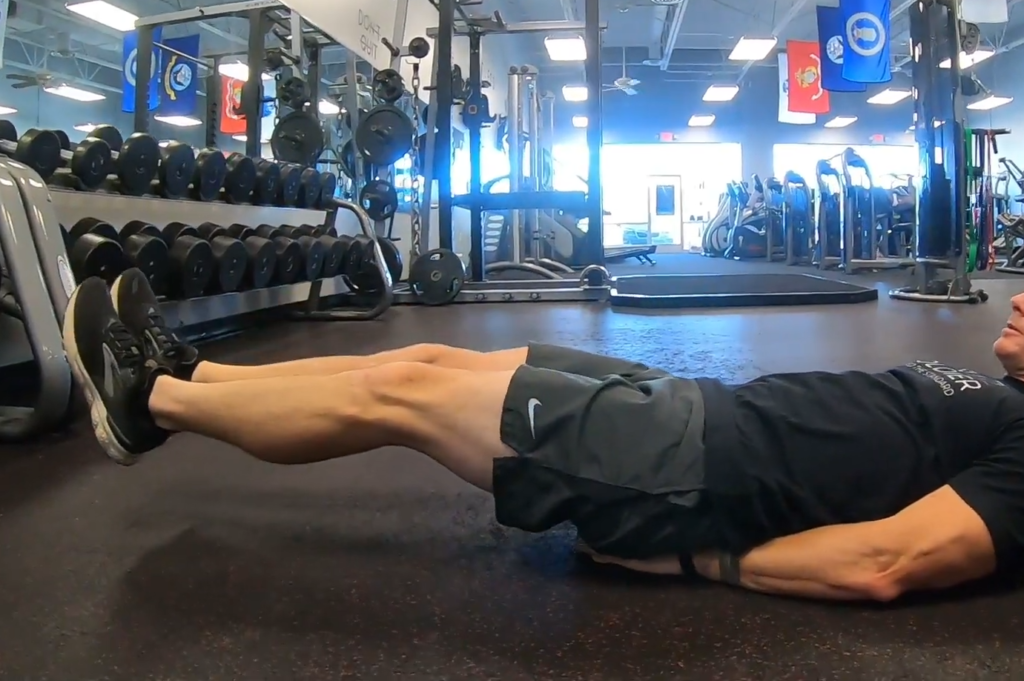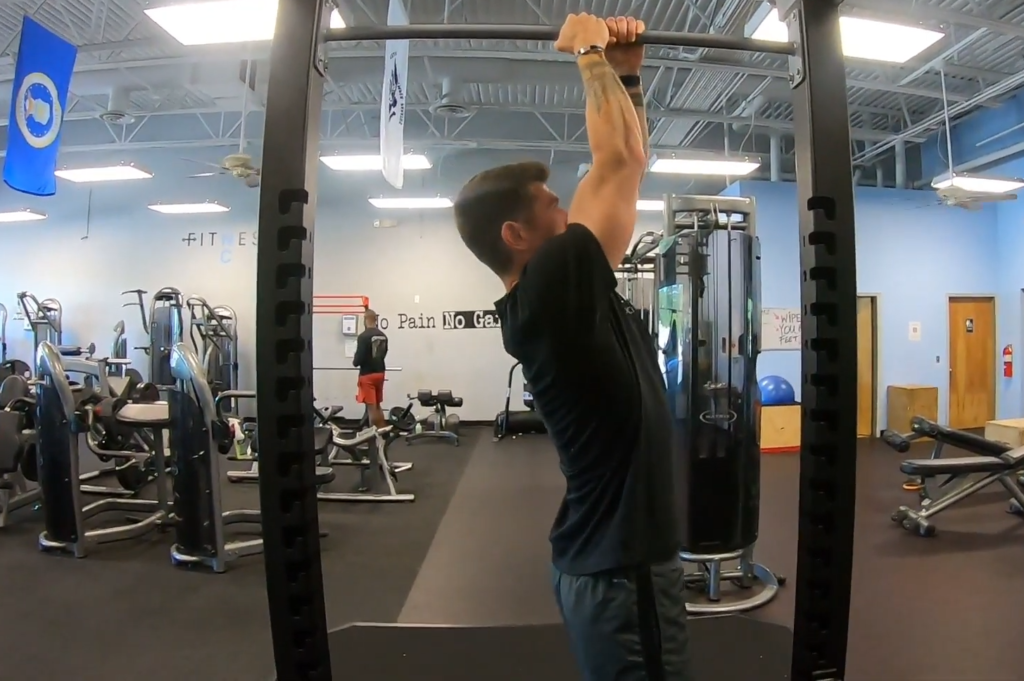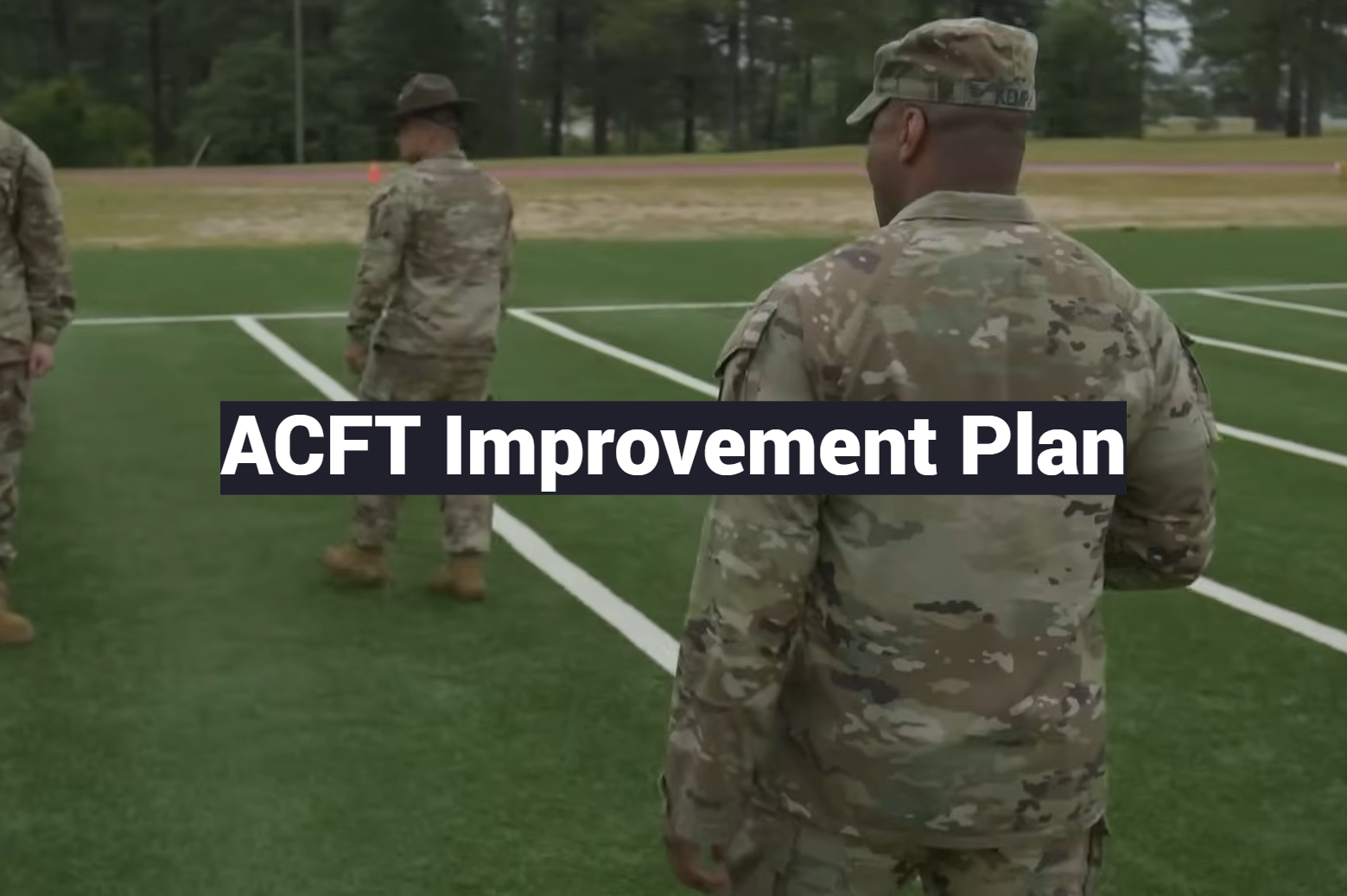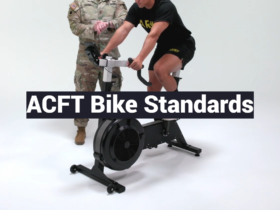The Army Combat Fitness Test (ACFT) is a comprehensive measure of a soldier’s physical readiness for the rigors of military service. Achieving a high score requires strength, endurance, agility, and a focused training plan. This article provides an ACFT Improvement Plan designed to help you elevate your performance across all test events. We’ll cover techniques to enhance your deadlifts, push-ups, and run times, and provide advice on how to prepare for the test both physically and mentally. Whether you’re aiming for a passing score or striving for perfection, this guide offers strategies to help you reach your ACFT goals.
What Happens If You Fail the ACFT?
[tds_note]The Army Combat Fitness Test (ACFT) is a significant component of the U.S. Army’s physical readiness training system, designed to assess a soldier’s physical fitness in areas crucial to combat readiness [1]. Introduced to replace the previous Physical Fitness Test (PFT), the ACFT aims to provide a comprehensive evaluation of a soldier’s strength, endurance, and agility. Given its importance, failing the ACFT can have substantial implications for a soldier’s career and the operational readiness of their unit.[/tds_note]

Immediate Consequences of Failing the ACFT
The ACFT consists of six events: the 3-repetition maximum deadlift, standing power throw, hand-release push-ups, sprint-drag-carry, leg tuck, and the 2-mile run. Each event is scored, with a minimum score required to pass. Failure to meet the minimum standards in any of these events results in failing the test.
Upon failing the ACFT, the immediate consequence for a soldier is the initiation of a mandatory remedial physical training program. The intent is to address the specific areas of weakness demonstrated during the test. Soldiers are typically given a certain timeframe to improve their performance, after which they must retake the ACFT.
Impact on Professional Development and Career Progression
Failing the ACFT can have significant implications for a soldier’s professional development and career progression. The U.S. Army considers physical fitness an integral part of a soldier’s overall effectiveness and readiness for combat.
Therefore, repeated failures can lead to adverse administrative actions, including:
- Bar to Reenlistment: Soldiers who consistently fail the ACFT may be barred from reenlisting, effectively ending their military career;
- Non-recommendation for Promotion: Physical fitness is a key consideration for promotion boards. A failure on the ACFT can lead to a non-recommendation for promotion, stalling a soldier’s career advancement;
- Removal from Leadership Positions: Soldiers in leadership positions may be removed if their physical fitness is deemed insufficient to meet the demands of their role, based on ACFT performance;
Remediation Process
The remediation process for soldiers who fail the ACFT is structured to provide targeted support to improve physical fitness levels. This process typically includes:
- Individualized Training Programs: Based on the areas of weakness identified during the ACFT, soldiers are given personalized training plans focusing on improving specific physical capabilities;
- Nutritional Guidance: Soldiers may also receive counseling on nutrition to support their physical training efforts and overall well-being;
- Regular Monitoring and Support: Commanders and physical training instructors closely monitor the soldier’s progress, providing support and adjustments to the training program as needed;
Re-testing and Long-term Implications
Soldiers undergoing remediation are required to retake the ACFT within a set period. Passing the retest is crucial for remaining in good standing within the unit and the Army at large. Continued failure can lead to more severe consequences, including separation from the Army under certain conditions.
The long-term implications of the ACFT extend beyond individual soldiers to the Army’s overall readiness and effectiveness [2]. The test is designed to ensure that all soldiers possess the physical fitness necessary for the demands of modern combat. By identifying and addressing physical fitness deficiencies, the ACFT aims to enhance the combat readiness and operational effectiveness of the U.S. Army.

The Broader Context: Shifting the Fitness Culture
The introduction of the ACFT represents a broader shift in the U.S. Army’s approach to physical fitness. Moving away from a one-size-fits-all fitness test, the ACFT is designed to be more closely aligned with the physical demands soldiers face in combat. This shift is also about changing the fitness culture within the Army, emphasizing a holistic approach to physical readiness that includes strength, endurance, and agility.
The ACFT encourages soldiers to adopt a more comprehensive fitness regimen, addressing areas that may have been neglected under the previous test. It also highlights the importance of physical fitness as a continuous requirement for military readiness, not just a checkbox for career progression.
How Can You Improve Your ACFT Score?
Improving your Army Combat Fitness Test (ACFT) score is crucial for career progression, operational readiness, and fulfilling the physical demands of military service. The ACFT is designed to assess a soldier’s physical fitness across a broad spectrum of tasks reflective of combat tasks, including strength, endurance, and mobility.
Here are comprehensive strategies to enhance your performance in each of the six events of the ACFT: the 3-repetition maximum deadlift, standing power throw, hand-release push-ups, sprint-drag-carry, leg tuck, and the 2-mile run.
1. 3-Repetition Maximum Deadlift
- Strength Training: Incorporate strength training into your routine, focusing on the muscles involved in deadlifting, such as the glutes, hamstrings, lower back, and core;
- Proper Technique: Ensure you are using the correct form to maximize efficiency and reduce the risk of injury. Work with a qualified instructor to refine your technique;
- Progressive Overload: Gradually increase the weight you lift over time to continuously challenge your muscles and improve strength;
2. Standing Power Throw
- Explosive Strength Exercises: Engage in exercises that build explosive strength, such as kettlebell swings, medicine ball throws, and plyometric exercises;
- Technique Practice: Work on the technique of the power throw, focusing on generating power from your legs through your core to your arms;
- Flexibility and Mobility: Improve your flexibility and mobility, especially in the hips and shoulders, to achieve a full range of motion for a more powerful throw;
3. Hand-Release Push-Ups
- Upper Body Strength: Increase your upper body strength with push-up variations, bench presses, and overhead presses;
- Core Stability: Strengthen your core muscles to maintain proper form during the push-ups. Planks and other core exercises can be very beneficial;
- Endurance Training: Build endurance in your chest, shoulders, and arms by increasing the volume of push-ups over time;
4. Sprint-Drag-Carry
- Interval Training: Incorporate sprint intervals into your training to improve speed and endurance;
- Strength and Conditioning: Work on leg strength and conditioning with exercises like squats, lunges, and deadlifts to improve your drag and carry performance;
- Practice the Events: Regularly practice the specific components of the sprint-drag-carry to improve your technique and efficiency;

5. Leg Tuck
- Core and Grip Strength: Focus on building core strength with exercises like leg raises, planks, and hanging knee raises. Improve your grip strength through exercises like dead hangs and farmer’s walks;
- Pull-Up Training: Since the leg tuck involves a similar motion to pull-ups, incorporating pull-ups into your training can be beneficial;
- Full Body Exercises: Engage in full body exercises that mimic the leg tuck movement to build coordination and strength across the required muscle groups;
6. 2-Mile Run
- Endurance Running: Build your running endurance with long-distance runs, gradually increasing the distance over time;
- Speed Work: Implement interval training and tempo runs to improve your speed and cardiovascular fitness;
- Proper Recovery: Ensure you are allowing adequate recovery time, including rest days and active recovery, to prevent overtraining and injuries [3];
General Tips for Improving Your ACFT Score
- Holistic Approach: Take a holistic approach to your fitness, focusing on nutrition, hydration, and sleep, as these factors significantly impact your physical performance and recovery;
- Consistency: Maintain a consistent training schedule. Regular, dedicated practice and exercise are key to improvement;
- Mental Preparation: Mental toughness and resilience are crucial for the ACFT. Practice visualization techniques and develop a positive mindset to face the challenges of the test;
- Seek Professional Guidance: Consider working with a physical trainer experienced in preparing individuals for the ACFT. They can provide personalized advice and adjustments to your training plan;
- Monitor Progress: Regularly assess your performance in each of the ACFT events to identify areas for improvement and adjust your training plan accordingly;
Your Monthly Improvement Plan:
This plan is structured to gradually build strength, endurance, and technique over a four-week cycle, with specific focuses on different days of the week to ensure comprehensive development and recovery.
Monday: All ACFT Events Training
Weeks 1, 4, 7: These weeks are dedicated to practicing all ACFT events in a single session. This approach not only helps in building endurance but also allows you to familiarize yourself with the test’s sequence and demands. Starting your week with a full test simulation sets a strong tone for the rest of your training, providing immediate feedback on areas requiring extra attention.

Tuesday: Med Ball Throws, Shuttle Sprint Repeats, 2-mile Run Work (800m Repeats)
- Med Ball Throws: Focus on technique and explosive power. Practice throwing with maximum force, aiming to increase your distance with each session;
- Shuttle Sprint Repeats: These are excellent for building speed and agility. Include short, high-intensity sprints with brief recovery periods to mimic the sprint-drag-carry event’s demands;
- 2-Mile Run Work (800m Repeats): These intervals help build speed and endurance specific to the 2-mile run. Aim to run each repeat at a pace faster than your goal race pace, with recovery intervals in between;
Wednesday: Dead Lifts, Hand Release Push Ups, Plank
- Dead Lifts: Focus on building strength in the legs, back, and core. Use a challenging weight yet allows you to maintain proper form for 3-5 sets of 5-10 repetitions;
- Hand Release Push-Ups: Aim for volume and endurance. Practice sets that push your limits while maintaining good form, focusing on chest, shoulder, and tricep strength;
- Plank: Building core stability is essential for almost every ACFT event. Hold planks for time, aiming to increase the duration with each session;
Thursday: Med Ball Throws, Sprint-Drag-Carry, 2-Mile Run Work (1-Mile Repeats)
- Med Ball Throws: Continue to work on explosive power, focusing on the technique and form required to maximize distance;
- Sprint-Drag-Carry: This event is a true test of speed, strength, and endurance. Practice each component individually, then combine them into a full event simulation to improve your overall performance;
- 2-Mile Run Work (1-Mile Repeats): These longer intervals aim to build endurance while maintaining a strong pace. Focus on running these repeats at or slightly below your target race pace, with adequate recovery between each;
Friday: Dead Lifts, Hand Release Push Ups, Plank
Repeat Wednesday’s Routine: This repetition reinforces the muscle memory and strength gains targeted on Wednesday. Consistency in these exercises is key to seeing improvements in strength and endurance.
Weeks 2-3 and 5-6: Focused Training Blocks
During these weeks, the training shifts to a more focused approach, targeting specific ACFT events that require significant strength and endurance:
- Dead Lifts: These weeks allow for a deeper focus on building leg, back, and core strength. Incorporating varied sets and repetitions can prevent plateaus and continue strength development;
- Hand Release Push Ups: Concentrated push-up training builds endurance and strength in the upper body, crucial for improving scores in this event;
- Plank: Continued emphasis on core strength supports improvements across all ACFT events, particularly those requiring core stability and endurance [4];
Recovery and Nutrition
[tds_council]Recovery is a critical component of any training plan. Ensure you’re getting adequate rest, with at least one full rest day per week to allow your body to recover and adapt to the training stresses. Incorporate active recovery days as needed, focusing on light cardio, stretching, and mobility work to maintain flexibility and reduce injury risk.[/tds_council]
Nutrition also plays a vital role in your training performance and recovery. Focus on a balanced diet rich in proteins, carbohydrates, healthy fats, and hydration to fuel your workouts and aid in muscle repair and recovery.

What Should You Focus on During Your ACFT Improvement:
Endurance
Endurance is the ability to sustain physical and mental effort over long periods. For the ACFT, both cardiovascular endurance and muscular endurance are crucial:
- Cardiovascular Endurance: Essential for the 2-mile run, improving cardiovascular endurance involves engaging in aerobic activities such as running, cycling, and swimming. Interval training and long-distance runs, progressively increasing in length and intensity, can significantly enhance your aerobic capacity;
- Muscular Endurance: Critical for events like the hand-release push-ups and the sprint-drag-carry, muscular endurance can be developed through high-repetition strength training and circuit workouts that mimic the ACFT’s demands;
Hypertrophy
Hypertrophy, the increase in muscle size, contributes to a higher potential for strength and power output. While not a direct focus of the ACFT, developing muscle mass can provide a solid foundation for strength and power exercises:
- Targeted Resistance Training: Incorporate exercises that target the major muscle groups used in the ACFT, focusing on moderate to high repetitions (8-12) with moderate weights;
- Variety in Training: Utilize a variety of resistance training methods, including free weights, resistance bands, and bodyweight exercises, to stimulate muscle growth from different angles and intensities;
Strength
Strength is the maximal force that a muscle or muscle group can exert in a single effort. It is foundational for ACFT events like the 3-repetition maximum deadlift:
- Progressive Overload: Gradually increase the weight, frequency, or number of repetitions in your training to continuously challenge your muscles to grow stronger;
- Compound Movements: Focus on compound exercises such as deadlifts, squats, and bench presses, which engage multiple muscle groups simultaneously, mimicking the functional movements of the ACFT and maximizing strength gains;
Power
Power is the ability to exert maximal force in minimal time, crucial for ACFT events like the standing power throw and the sprint-drag-carry:
- Explosive Training: Incorporate plyometric exercises (e.g., box jumps, medicine ball throws) and Olympic lifts (e.g., clean and jerk, snatch) into your routine to enhance neuromuscular efficiency and explosive power;
- Speed Strength Training: Engage in training that focuses on moving weights rapidly, such as kettlebell swings or speed squats, to improve the rate of force development;
Integrating the Focus Areas into Your Training Plan
A well-rounded training plan for the ACFT should integrate all four focus areas in a balanced manner, ensuring that you’re developing endurance, hypertrophy, strength, and power concurrently. This integrated approach not only prepares you for the specific demands of each ACFT event but also builds a comprehensive fitness foundation that enhances overall performance and resilience.
- Periodization: Structure your training program in cycles that focus on different attributes at different times, gradually building up to peak performance for test day;
- Recovery and Nutrition: Pay attention to recovery techniques, including adequate rest, active recovery, and proper nutrition, to support your body’s ability to adapt and grow stronger in response to training;
- Consistency and Variation: Maintain a consistent training schedule while also incorporating variation in your exercises, intensity, and volume to prevent plateaus and continue making progress;

FAQ:
1. How can you improve your ACFT?
Improving your ACFT score requires a combination of strength training, cardiovascular exercise, and proper nutrition. Incorporating exercises that target the muscle groups used in the ACFT events can also help improve your performance.
2. How can you improve your combat fitness?
Combat fitness can be improved by incorporating functional fitness exercises into your routine, focusing on strength, endurance, and agility. This includes weight lifting, high-intensity interval training (HIIT), and flexibility exercises.
3. How do you prepare for the ACFT in a week?
While it’s not possible to drastically improve your fitness level in a week, you can focus on practicing the specific events of the ACFT, ensuring proper form and technique, and getting plenty of rest.
4. How hard is it to get a 600 on the ACFT?
Achieving a perfect score of 600 on the ACFT is challenging and requires excellent physical condition across all test events. This level of fitness is typically achieved through consistent, dedicated training over time.
5. How many people fail the ACFT?
The failure rate for the ACFT varies, but according to the Army Times, as of October 2020, roughly 7% of soldiers were failing the test.
6. What is a good ACFT score?
A good ACFT score is generally considered to be 500 or above, which would place you in the “Gold” category. However, the “good” score can vary depending on the individual’s age, gender, and role in the Army.
7. Can you pass the ACFT without training?
Passing the ACFT without training is unlikely, especially if you are not regularly active or have a sedentary lifestyle. The ACFT is designed to test your physical fitness and readiness for military service, which requires a good level of strength, endurance, and agility.
8. How do you prepare for an ACFT the night before?
The night before the ACFT, ensure to get a good night’s sleep, hydrate, and eat a balanced meal. Avoid strenuous exercise to allow your muscles to rest and recover.
9. What is the alternative to deadlifts for ACFT?
There is currently no official alternative to the deadlift in the ACFT. However, exercises like squats or kettlebell swings can help to build similar muscle groups.
10. How long should the ACFT last?
The ACFT is designed to be completed within 50 minutes, not including the set-up and warm-up time.
11. How can you improve my ACFT deadlift?
Improving your ACFT deadlift can be achieved by incorporating regular strength training focusing on your lower back, glutes, and hamstrings. Practicing the correct form is also crucial.
12. Is the ACFT hard to pass?
The difficulty of passing the ACFT depends on the individual’s physical fitness level. For someone in good physical condition who trains regularly, it may not be as challenging.
13. How do you recover from ACFT?
Recovery after the ACFT should include rehydrating, eating a balanced meal to replenish energy stores, and taking time for light active recovery exercises and stretching.
14. What are 10 preparatory drills?
The 10 preparatory drills in the Army Physical Readiness Training (PRT) system are Bend and Reach, Rear Lunge, High Jumper, Rower, Squat Bender, Windmill, Forward Lunge, Prone Row, Bent-leg Body Twist, and Push-up.
15. What is the lowest passing score for ACFT?
The lowest passing score for the ACFT is 360, with a minimum of 60 points in each event.
16. How do you increase your run time in ACFT?
Increasing your run time for the ACFT can be achieved by incorporating more cardio into your workout routine, doing interval training, and practicing proper running form.
17. How do you max push-ups on ACFT?
To max out push-ups on the ACFT, focus on upper body strength training, particularly the chest, shoulders, and triceps. Also, practice the correct push-up form and regularly perform push-ups to increase your endurance.
18. What is the national average for ACFT?
As per the data available to date, the national average for the ACFT isn’t published. However, generally, a score of 500 or above is considered good and places you in the “Gold” category.
Useful Video: How to Train for the ACFT | Alternative Exercises to Help You MAX the Army’s PT Test
References:
- https://www.moore.army.mil/MCoE/TAP-C/Content/PDF/ACFT_Improvement_Plan.pdf
- https://mtntactical.com/shop/army-combat-fitness-test-acft-training-plan/
- https://www.armycombatfitnesstest.com/progression
- https://www.army.mil/e2/downloads/rv7/acft/acft_training_guide_final.pdf






Leave a Reply